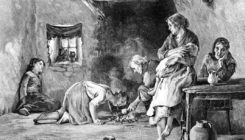In 2001 my old school friend Ann Shaw bought South Reen Farm, which was adjacent to her home on Blind Harbour. Ann stopped in to tell Mary O’Sullivan, an elderly neighbour whom Ann had known since she was a child forty years earlier, about the purchase. Over a cup of tea, Mary shared a schoolbook she had kept since her childhood. In it, for the first time, Ann read the letter written in December 1846 to the Duke of Wellington from Nicholas Marshall Cummins describing the devastation at South Reen, the first account of the Potato Famine in Ireland to be published in England. In all the years Ann had lived in this corner of South West Cork no one had ever mentioned the terrible suffering of its residents during the Famine. In his letter Cummins states that “one townland . . . is named South Reen . . . and on reaching the spot I was surprised to find the wretched hamlet apparently deserted. I entered some of the hovels to ascertain the cause . . . six famished and ghastly skeletons, to all appearance dead, were huddled in a corner on some filthy straw, their legs hanging about, naked above the knees. I approached in horror, and found by a low moaning they were alive, they were in fever—four children, a woman, and . . . a man. . . . in a few minutes I was surrounded by at least 200 such phantoms, such frightful specters as no words can describe.”
After learning about the NM Cummins letter Ann telephoned me to ask if I might be related to him as she remembered that my father was born in County Cork and Cummins is not an uncommon name there. I asked my father and found out that NM Cummins was, indeed, a relation. Suddenly a place I had visited many times held a new element of connection.
When Ann Shaw walked around South Reen Farm with her friend Susan O’Toole, she explained to Susan the horror that had occurred on the land underneath their feet and the desolation that was left behind. Later, Susan asked if she might create a memorial to the Famine victims of South Reen. Ann agreed immediately and gave Susan free rein to create whatever she wanted and to place it anywhere on the land. After additional walks and contemplation Susan sketched out a design she called “The Tree Sentinels.” Susan envisioned a crescent-shaped line of eighteen trees standing twenty-seven feet high and three feet apart, looking toward the sea and the horizon, marking and keeping safe the memory of those who suffered in that dreadful time. In the late summer of 2001 Ann and Susan began the construction of “The Tree Sentinels.” Sixteen years later, only three and a half silent Sentinels remain standing, the others having fallen to the ground and been covered by grass.
Susan O’Toole has again been moved by the plight of the long-departed residents of South Reen and the hardship they endured. This time she imagines their suffering through poetry and drawings. Remembering those unmourned and breaking the silence that surrounds that time is the string that resonates throughout these poems and drawings and photographs.
Amanda Cummins
Warwickshire, England
June 2017


